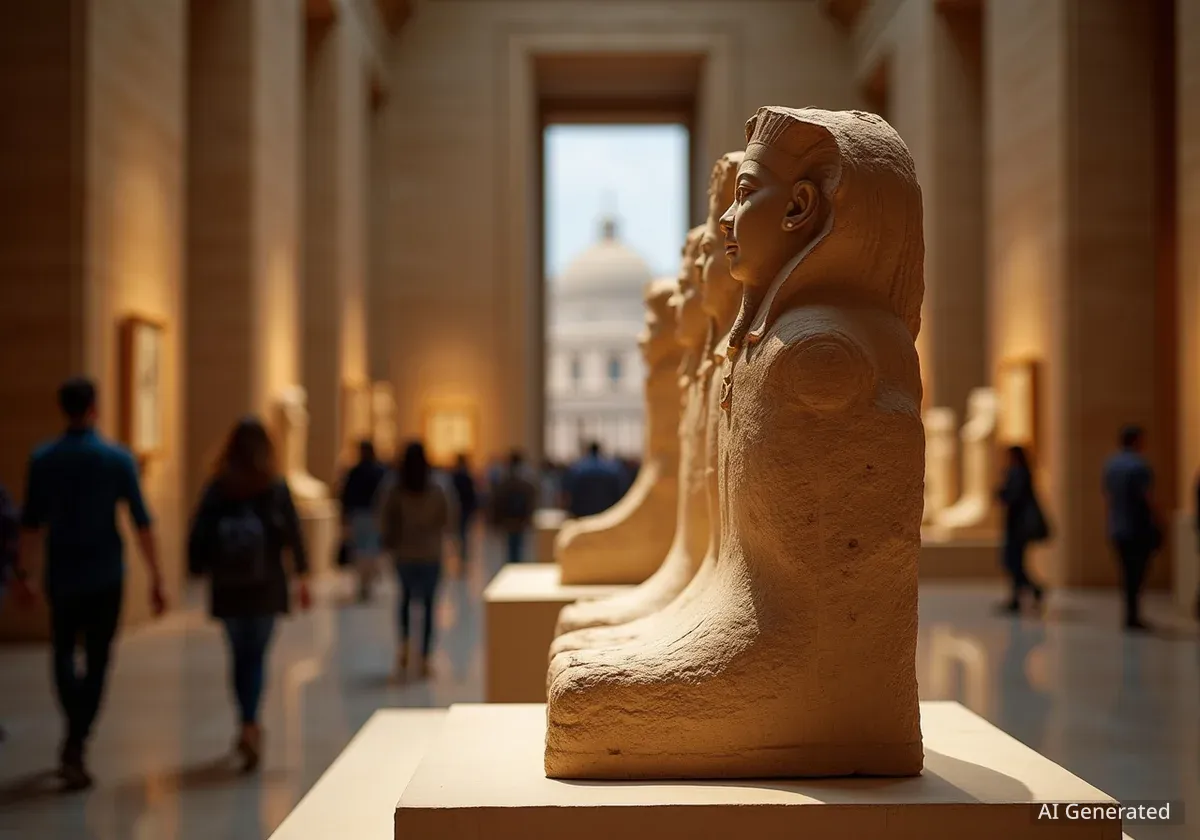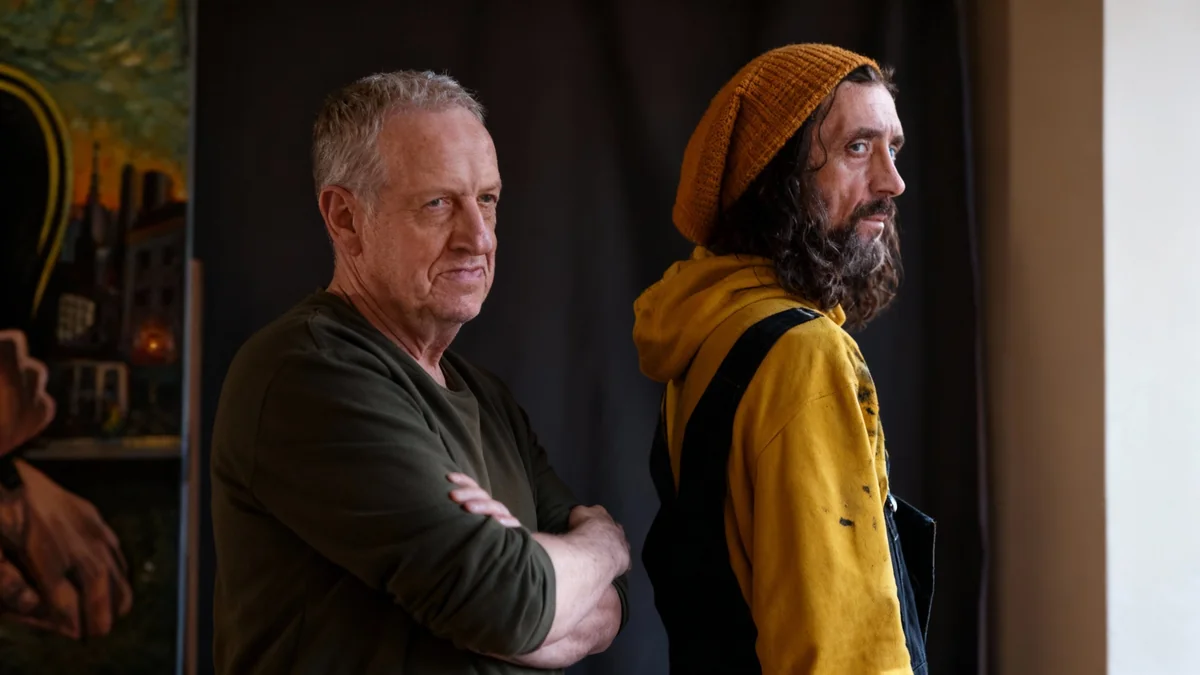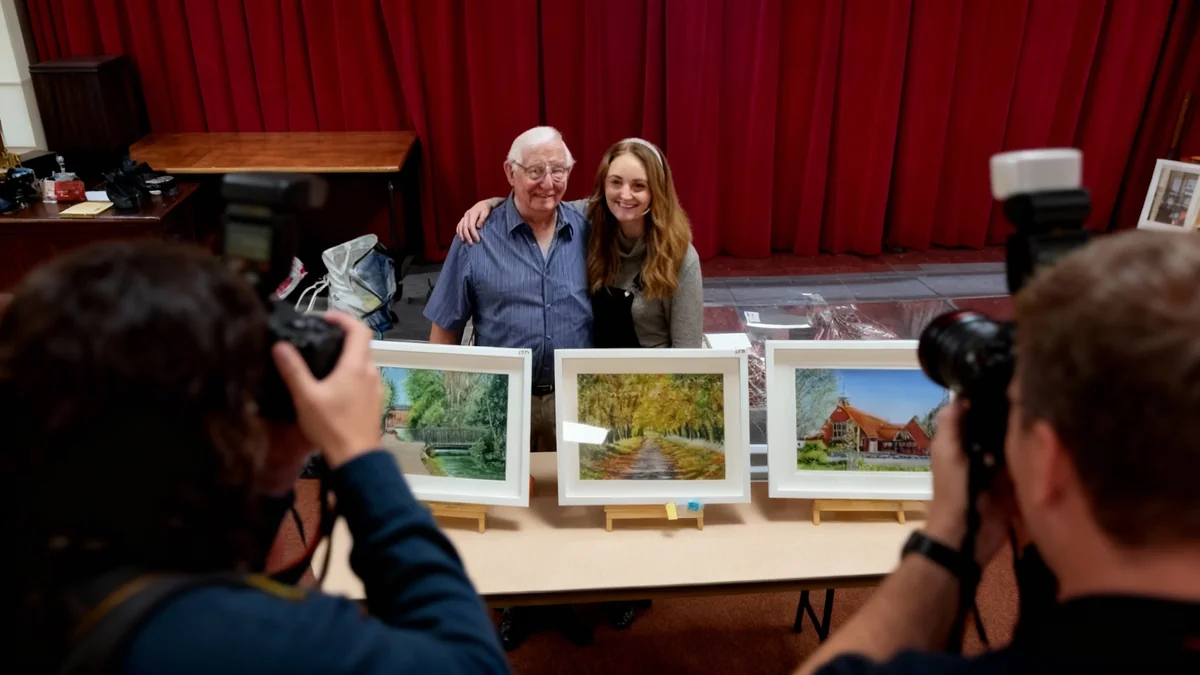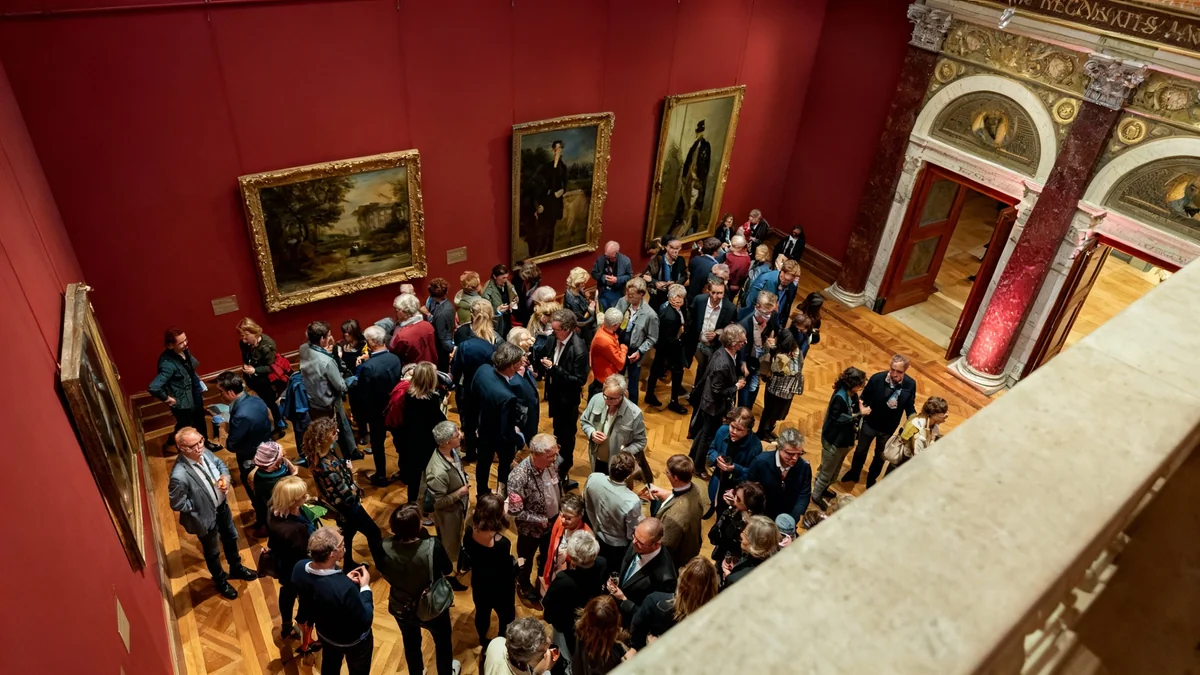The Metropolitan Museum of Art in New York City houses a vast collection spanning over 5,000 years of human creativity. As one of the world's largest and most comprehensive encyclopedic museums, it offers visitors a unique journey through diverse cultures and historical periods. Navigating its extensive galleries can be challenging, but focusing on certain iconic works provides a rich and rewarding experience.
This guide highlights significant pieces across various wings, offering a curated path for those with limited time or seeking a deeper connection with specific cultural narratives. From ancient Egyptian tombs to European masterpieces and modern art, the Met's collection reflects humanity's artistic achievements.
Key Takeaways
- The Met's collection spans over 5,000 years of global art.
- Key exhibits include the Temple of Dendur, "William" the Hippopotamus, and Renaissance paintings.
- New installations and ongoing renovations mean some works may be temporarily off view.
- The museum actively addresses repatriation requests and collection rehangs.
- Planning your visit using the Met's official website is highly recommended.
Ancient Civilizations: Egypt, Greece, and Rome
The Egyptian galleries are among the most popular, drawing visitors with their monumental scale and historical depth. Here, ancient structures and artifacts tell stories of pharaohs, gods, and daily life along the Nile.
The Mastaba Tomb of Perneb
Dating from approximately 2381–2323 BCE, the Mastaba Tomb of Perneb offers a rare interactive experience. This ancient walk-in structure, once part of a larger rectangular tomb, housed the body of a priest and prince. Visitors can enter the reconstructed serdab, or statue chamber, where painted reliefs depict Perneb's connection to Ra, the sun god. Although the original obelisks are no longer present, the tomb maintains its powerful presence.
Fact: Fifth Dynasty Relic
The Mastaba Tomb of Perneb dates to Egypt's Fifth Dynasty, a period of significant architectural and artistic development in the Old Kingdom.
Hippopotamus ("William")
The faience sculpture known as "William" the Hippopotamus, created around 1961–1878 BCE, is a beloved icon. While modern viewers find it charming, in ancient Egypt, hippos symbolized wild and dangerous nature. Treasurer Senbi II was interred with this blue-glazed, lotus-painted sculpture, possibly to symbolize control over such forces. It has been a major attraction for over 4,000 years, earning its affectionate nickname from a British humor magazine in the 1930s.
Seated Statue of Hatshepsut
The Seated Statue of Hatshepsut (1479–1458 BCE) highlights the remarkable reign of a female pharaoh who defied traditional gender roles. This limestone sculpture, originally painted blue, is notable for clearly depicting Hatshepsut as a woman, with visible breasts, in contrast to many of her other representations that portrayed her with masculine features. She is shown seated, wearing a kilt-like garment, ready to receive offerings.
Fragment of a Queen’s Face
A Fragment of a Queen’s Face, carved from jasper around 1390–1336 BCE, offers both beauty and mystery. The identity of the woman, potentially Queen Nefertiti, and the rest of the sculpture remain unknown. However, the finely sculpted lips, pressed into a knowing expression, convey enduring intrigue and artistic mastery.
Temple of Dendur
The Temple of Dendur, circa 10 BCE, is perhaps the Met's most famous Egyptian artifact. Housed in its own spacious gallery, this sandstone temple from the Roman period was dedicated to the goddess Isis. It features sculpted lotus flowers, hieroglyphics, and images of Caesar Augustus. Egypt gifted the temple to the United States in 1965 for its contribution to a UNESCO fund. It opened at the Met in 1978, becoming a symbol of international cultural exchange.
Historical Context: The Temple of Dendur's Journey
The Temple of Dendur was saved from flooding caused by the Aswan High Dam. The United States provided $16 million to a UNESCO preservation fund, leading to Egypt's gift of the temple. Its installation at the Met required a specially designed gallery, showcasing its grandeur.
Portrait of the Boy Eutyches
The Portrait of the Boy Eutyches (100–150 CE) illustrates the rich cultural blending during Egypt's Roman rule. This encaustic painting, created by mixing pigment with hot wax, features a Roman style. However, its original purpose was distinctly Egyptian: it was placed over a mummy's face. This work is one of roughly 1,000 surviving Fayum portraits, many discovered in Egypt's Faiyum Basin.
Marble Seated Harp Player
From the Greek and Roman galleries, the Marble Seated Harp Player (2800–2700 BCE) from the Cyclades islands demonstrates early artistic innovation. This stylized sculpture depicts a seated figure playing a kithara, a lyre-like instrument. Its smooth marble and minimalist forms, combining angular and arced lines, influenced later Greek artists and even modern art movements.
Terracotta Stirrup Jar with Octopus
The Terracotta Stirrup Jar with Octopus (circa 1200–1100 BCE) from Mycenaean culture, though functional for carrying liquids, is admired today for its artistic design. A stylized octopus with splayed tentacles and swimming fish adorns its surface. This ancient vessel's simplicity has inspired modernists centuries later.
Art from Africa, Oceania, and the Ancient Americas
The Michael C. Rockefeller Wing, recently renovated, offers a profound look into the artistic traditions of Africa, Oceania, and the ancient Americas. Textiles, sculptures, and ceremonial objects highlight diverse cultural practices.
Seated Hollow Figure with Helmet
The Seated Hollow Figure with Helmet (1200–800 BCE) is an Olmec "baby" sculpture from present-day Mexico. Its exact purpose remains unknown, with theories suggesting it honored a lost child or depicted an adult in a younger form. Crafted from ceramic with white slip and red highlights, its naturalistic depiction of a flabby stomach is striking.
Wari Tunic
A Wari people's Tunic (650–1000 CE) from ancient Peru is a textile marvel. Unlike other Wari tunics with grid-like patterns, this piece features a dynamic cascade of zigzags, circles, and hash marks, giving it a surprisingly contemporary feel. Its inclusion in the rehung Rockefeller Wing highlights textiles as a significant art form.
Ùhúnmwèlaò (Head of an Óbà)
The 16th-century bronze Ùhúnmwèlaò (Head of an Óbà) from the Kingdom of Benin is not a precise portrait but rather a representation of a ruler's power. These valuable sculpted heads were widely collected by museums. However, this piece, part of the Benin Bronzes, was stolen in 1897 by British troops. While the Met has returned some bronzes, this one remains in New York, symbolizing ongoing discussions about repatriation.
"Sculpted heads such as this one were particularly valuable in Benin, and they have been collected widely by museums—though there is now a push to start sending them back home."
Pendant Mask of Ìyọ́bà Idià
The 16th-century Pendant Mask of Ìyọ́bà Idià, an iconic work in the Rockefeller Wing, likely depicts Idia, mother of Benin ruler Esigie. Carved from ivory, it features bearded coral figures (Portuguese traders) at the bottom and mudfish forming a tiara. This mask was also plundered by British soldiers in 1897. The Met's recent repatriations of other Benin Bronzes underscore the evolving dialogue around colonial acquisitions.
Wunkirmian or Wakemia Feasting Spoon
The 19th to mid-20th-century Wunkirmian or Wakemia Feasting Spoon by a Dan artist from Liberia and Côte d’Ivoire is anthropomorphized with legs and a concave upper portion forming a head. Its abstracted human form has influenced modern sculptors like Alberto Giacometti and Simone Leigh, highlighting its enduring artistic appeal.
Mangaaka Power Figure
The Mangaaka Power Figure (circa 1880–1900), known as a nkisi nkondi, was created by the Kongo people of Central Africa. These statuettes were believed to possess mythical power, often embedded with metal pieces and medicinal matter, to ward off evil and offer protection.
Yoruba Beaded Crown (Adéńlá)
A late 19th–early 20th-century Yoruba Beaded Crown (Adéńlá) from Nigeria showcases intricate bead art. Its vibrant glass elements form abstract patterns and faces with protruding eyes and thin smiles, featuring ojú-ọnà, a unique Yoruba design sense. Once worn by a Yoruba leader and containing herbal medicines, it is a highlight of the renovated Rockefeller Wing.
Asian Art: Diverse Traditions and Spiritual Expressions
The Asian art wing, often quieter, holds treasures that reveal the cross-cultural dialogues and spiritual depths of the continent. From ancient Buddhas to intricate garden courts, these works span millennia.
Head of a Buddha
A 5th-century Head of a Buddha, possibly from Hadda, a Greco-Buddhist site in Afghanistan, exemplifies hybrid artistic styles. Its almond-shaped eyes and thin eyebrows reflect Indian aesthetics, demonstrating the extensive cultural exchange across Asia during that period.
Standing Ganesha
The 7th-century Standing Ganesha from the Pre-Angkor period in India showcases a shift towards more naturalistic depictions of the Hindu deity. Unlike earlier idealized forms, this sculpture highlights Ganesha's bulging stomach beneath a sampot garment, suggesting a more human portrayal of the divine.
Chamunda, the Horrific Destroyer of Evil
The 10th–11th-century sandstone sculpture of Chamunda, the Horrific Destroyer of Evil, from ancient India, is a fearsome representation of the Hindu goddess. With sharp teeth and a skull tiara, it projects immense power. Originally, this Chamunda had 12 arms, many holding weapons, according to the Met.
Shiva as Lord of Dance (Nataraja)
The 11th-century bronze sculpture, Shiva as Lord of Dance (Nataraja), emerged during the Chola dynasty in southern India. This depiction of Shiva dancing with flying hair, surrounded by a ring of fire (prabhamandala), symbolizes the eternal cycle of time and cosmic energy.
Did You Know? Chola Dynasty Bronze
The Chola dynasty (9th to 13th centuries) in southern India saw a "mini-renaissance" in bronze sculpture, leading to more naturalistic representations of Hindu deities.
Buddha of Medicine Bhaishajyaguru (Yaoshi fo)
The colossal Buddha of Medicine Bhaishajyaguru (Yaoshi fo), circa 1319, is one of the largest paintings regularly displayed at the Met. This Yuan dynasty masterpiece, standing 24 feet tall and 49 feet wide, features Bhaishajyaguru at its center, flanked by bodhisattvas Candraprabha and Suryaprabha, and other figures witnessing his healing powers. Its original setting was the Lower Guangsheng Temple in Shanxi province.
Astor Chinese Garden Court
The Astor Chinese Garden Court, created in the style of the 17th century, is a result of the first cultural agreement between the Met and China after the Communist Party came to power in 1979. Conceived by Brooke Astor as a faithful replica of a Ming Dynasty garden, it includes real Taihu rocks, live bamboo, and traditional circular designs. Completed in 1981, it remains a diplomatic achievement and a tranquil space within the museum.
European Masterpieces: From Medieval to Modern
The European paintings and sculpture galleries showcase centuries of artistic evolution, from the solemnity of medieval religious art to the dramatic emotionality of the Baroque and the innovations of the Impressionists.
Duccio, Madonna and Child
Duccio's Madonna and Child, circa 1290–1300, marked a turning point in 13th-century Italian painting. Duccio humanized biblical figures, depicting the infant Christ playfully lifting the Virgin Mary's veil. Despite the gold-leaf background, the inclusion of a parapet similar to those in Siena grounds the scene in a relatable reality. The Met acquired this significant work for $45 million in 2004.
Giotto di Bondone, The Adoration of the Magi
Following Duccio, Giotto di Bondone further humanized Christian narratives. His The Adoration of the Magi, circa 1320, attributed to one of his followers, demonstrates his psychological depth in portraying characters. The caring gaze of the Virgin Mary and the individualized angels are hallmarks of the pre-Renaissance master. This work is part of a series of seven valuable paintings depicting Christ's life.
Pieter Bruegel the Elder, The Harvesters
Pieter Bruegel the Elder's The Harvesters, 1565, is a celebrated landscape painting. It features tiny figures of hay harvesters within a vast Flemish landscape. Bruegel's meticulous attention to each laborer, whether working, resting, or playing a ball game in the distance, creates a sense of an entire world existing beyond the canvas.
El Greco, View of Toledo
El Greco's View of Toledo, circa 1599–1600, is one of only two surviving landscapes by the Spanish master. The painting's dark, dynamic mood, with swaying trees and buildings clinging to hillsides, offers a subjective, expressive perspective of the city. This departure from traditional perspective later influenced artists like Picasso.
Diego Velázquez, Juan de Pareja
Diego Velázquez's Juan de Pareja, 1650, is a renowned portrait acquired by the Met in 1971 for $5.5 million. Juan de Pareja was an enslaved painter in Velázquez's household, whom Velázquez began to free in 1650. The portrait is admired for its striking contrast of an inky black background and luminous white highlights on Pareja's skin. A 2023 Met exhibition specifically on Pareja highlighted the painting's significance as a document of racial tensions during its era.
Rembrandt van Rijn, Self-Portrait
Rembrandt van Rijn's Self-Portrait, 1660, captures the artist in his mid-50s. His aging features—sagging eyes, gray hair, and forehead creases—are rendered against a characteristic brown background. The painting remarkably balances darkness with glimmers of light, particularly on his ruddy nose, reflecting his mastery of light and shadow.
Johannes Vermeer, Allegory of the Catholic Faith
Among the Met's five Vermeer paintings, the Allegory of the Catholic Faith, circa 1670–72, stands out for its intricate symbolism and masterful portrayal of light. The central female figure personifies Faith, surrounded by visual rhymes like a sculpted crucifix mirroring a painting of Christ, and a glass orb reflecting the globe. Vermeer suggests that religious devotion shapes an entire worldview.
Vermeer's Allegories
Johannes Vermeer is known for his domestic scenes and his exceptional use of light. His allegorical paintings, like this one, often weave complex symbolic narratives into seemingly everyday settings, inviting viewers to contemplate deeper meanings.
Adélaïde Labille-Guiard, Self-Portrait with Two Pupils
Adélaïde Labille-Guiard's Self-Portrait with Two Pupils, Marie Gabrielle Capet and Marie Marguerite Carreaux de Rosemond, 1785, boldly asserts women's place in the arts. In 18th-century France, female artists faced significant obstacles. Labille-Guiard's painting, showing herself instructing two female students, challenges the notion that "great women artists" were absent from history, a point later explored by art historian Linda Nochlin.
American Art: Landscapes, Portraits, and Social Narratives
The American Wing offers a diverse collection, from iconic landscapes of the Hudson River School to portraits and works that address complex social issues, reflecting the nation's evolving identity.
Joshua Johnson, Emma Van Name
Emma Van Name, circa 1805, is the most recognized painting by Joshua Johnson, one of the first known Black artists in the United States. This portrait of a strawberry-loving Maryland toddler embodies a distinctly American folk aesthetic with its flat background and intriguing details. The painting's history includes a controversial sale by the Whitney Museum in the 1980s, sparking public protest.
Thomas Cole, The Oxbow
Thomas Cole's View from Mount Holyoke, Northampton, Massachusetts, After a Thunderstorm—The Oxbow, 1836, is an iconic Hudson River School landscape. It captures the Connecticut River Valley after a storm, with Cole himself depicted as a tiny figure painting on a cliff. The painting's sublime beauty, showcasing the river's U-shaped bend and undeveloped mountains, also highlights the historical erasure of Native Americans from such landscapes, a theme contemporary Indigenous artists continue to address.
George Caleb Bingham, Fur Traders Descending the Missouri
George Caleb Bingham's Fur Traders Descending the Missouri, 1845, originally titled "French Trader & Half breed Son," subtly addresses racial tensions in America's expanding economy. Despite its serene depiction of a canoe on rippling waters, with a cat leashed to the prow, the painting's original title reveals underlying political complexities. This contrast between peaceful vista and social issues makes the work compelling for contemporary viewers.
David Drake, Storage Jar
David Drake's Storage Jar, 1858, from Edgefield, South Carolina, is a powerful example of pottery created by enslaved individuals. This stoneware jar, used for food storage, bears an inscribed message: "when you fill this Jar with pork or beef / Scot will be there; to get a peace." These words foreshadow Drake's eventual freedom after the Civil War. His signature, "Dave," asserted his personhood in a time when it was denied.
John Singer Sargent, Madame X
John Singer Sargent's Madame X (Virginie Amélie Avegno Gautreau), 1883–84, caused a scandal at the 1884 Paris Salon due to its overt sensuality. Sargent initially concealed the subject's identity, Virginie Amélie Avegno Gautreau, leading to the painting's "Madame X" moniker. Over time, the work has been recognized as a landmark piece that challenged bourgeois sexual norms and anticipated more provocative art.
Winslow Homer, The Gulf Stream
Winslow Homer's The Gulf Stream, 1899, is a potent allegory for Black life in post-Civil War America. It depicts a Black man in a boat amidst turbulent waters, surrounded by sharks and an approaching storm. His resigned expression suggests an acceptance of his treacherous situation. This timeless image continues to resonate, inspiring contemporary artists like Kerry James Marshall.
Mary Cassatt, Young Mother Sewing
Mary Cassatt's Young Mother Sewing, 1900, portrays the dignity of domestic labor. The American Impressionist depicts a mother so engrossed in sewing that she does not acknowledge the child on her lap. The scene is peaceful, with sunlight and flowers, yet the mother's focused gaze underscores the seriousness of her task, contrasting with the painting's alluring pastel colors.
Modern and Contemporary Art: Innovations and Reflections
The modern and contemporary art galleries at the Met showcase pivotal movements and artists who reshaped artistic conventions, from Cubism to Abstract Expressionism and beyond.
Pablo Picasso, Still Life with a Bottle of Rum
Pablo Picasso's Still Life with a Bottle of Rum, 1911, is a prime example of Analytic Cubism. This work, part of the Met's extensive Cubist collection, breaks objects into geometric shapes, offering multiple perspectives simultaneously. The rum bottle recedes as newspaper letters fly around, creating a chaotic, yet meticulously structured, tableau that challenged traditional representation.
Thomas Hart Benton, America Today
Thomas Hart Benton's mural cycle, America Today, 1930–31, is a significant acquisition for the Met's modern and contemporary holdings. Originally in the New School's boardroom, these eight sprawling panels depict distinctly American imagery: diverse workers building ships, vaudeville dancers, and drinkers. Benton, a leader of the Regionalist movement, captures the dynamism and social fabric of 1930s America.
Leonora Carrington, Self-Portrait
Leonora Carrington's Self-Portrait, circa 1937–38, is an iconic Surrealist work. Carrington sits stoically, pointing at a lactating hyena, while a rocking horse hangs and a mare prances outside. The painting's cryptic imagery, drawing on Celtic lore where horses aid travel between realms, resists easy explanation, reflecting the Surrealist interest in the irrational and subconscious. It entered the Met's collection in 2002.
Florine Stettheimer, The Cathedrals of Art
Florine Stettheimer's The Cathedrals of Art, 1942, is a joyful celebration of New York's museums. Stettheimer places the Met at the center, with a grand staircase leading to Egyptian sculpture and Old Master paintings, flanked by the Museum of Modern Art and the Whitney. The inclusion of "Baby Art" being led up the stairs by then-Met director Francis Henry Taylor playfully suggests the Met's central role in guiding artistic discourse.
Jackson Pollock, Autumn Rhythm (Number 30)
Jackson Pollock's Autumn Rhythm (Number 30), 1950, is a seminal work of Abstract Expressionism. Pollock created this piece by laying his canvas flat and splattering black and white paint, resulting in an "all-over" composition beyond his complete control. Art critic Allan Kaprow famously stated that Pollock "destroyed painting" by radically altering its traditional practice, making this work a pilgrimage point for modern art enthusiasts.
Ellsworth Kelly, Blue Green Red
Ellsworth Kelly's Blue Green Red, 1963, is a minimalist painting that explores optical perception. While the title describes its components—a green flow interrupted by a blue curve and a red field—prolonged viewing causes the colors to subtly shift. This work embodies the dictum "What you see is what you see," challenging rational rules of perception through its simple yet profound abstraction.
Kerry James Marshall, Untitled (Studio)
Kerry James Marshall's Untitled (Studio), 2014, demonstrates how contemporary artists engage with art history. Marshall often borrows elements from historical paintings, remixing them to address Blackness, a topic frequently absent in Old Master works. His painting of an artist's studio, complete with paint-splattered easels, includes Black figures often unseen in traditional art, asserting their presence within the institutional walls that once overlooked them.




